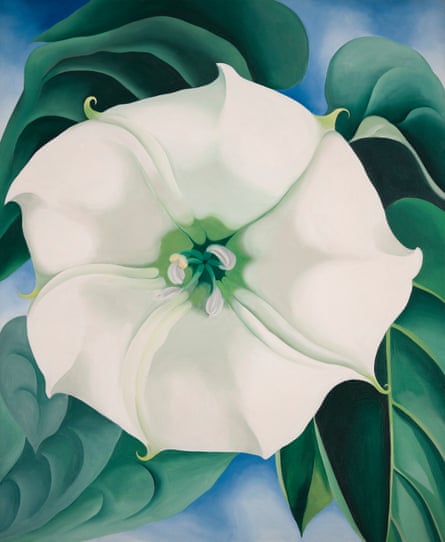There are few artists in history whose work is consistently reduced to the single question: flowers or vaginas?
But a new Tate Modern retrospective of Georgia O’Keeffe, a giant of American 20th-century modernism, is to challenge the “conservative male” – and widely accepted – assumptions that her famous flowers paintings are depictions of female genitalia.
The show, which opens in July, will be the UK’s largest ever exhibition of O’Keeffe’s work and will be Tate Modern’s first show since its £26m revamp. Featuring more than 100 works, which have rarely left America since her death in 1986, it will display her 1932 Jimson Weed painting, which in 2014 became the most expensive painting sold at auction by a female artist when it was bought for $44.4m.

It has been exactly a century since O’Keeffe first showed her work at 291 gallery in New York, and she is still considered one of the most celebrated painters of the 20th century.
She is best known for her large-scale studies of flowers, painted as if looking at them through a magnifying glass. However, since the early 1920s the vast oil works have been dogged by erotic interpretations and, despite O’Keeffe’s six decades of vigorous denial that her paintings were in any way sexual, it remains a commonly held assumption to this day.
Achim Borchardt-Hume, the Tate Modern’s director of exhibitions, said a key reason for hosting the retrospective was to offer O’Keeffe the “multiple readings” she had been denied in the past as a female artist.
“O’Keeffe has been very much reduced to one particular body of work, which tends to be read in one particular way,” he said. “Many of the white male artists across the 20th century have the privilege of being read on multiple levels, while others – be they women or artists from other parts of the world – tend to be reduced to one conservative reading. It’s high time that galleries and museums challenge this.”
Tanya Barson, who will curate the Tate Modern show, emphasised how much O’Keeffe had resisted the sexual reading into her paintings, which began in the 1920s but was then revived by feminists in the 1970s who took her work as a statement of female empowerment.
The Freudian theory that her flower paintings were actually close studies of the female vulva were first put forward in 1919 by Alfred Stieglitz, the photographer who first promoted O’Keeffe’s work and later became her husband.
Barson said she hoped the Tate retrospective would illustrate how this “cliched interpretation”, written almost 100 years ago and perpetuated by male art critics at the time, was “gendered and outdated”.

“I think it is time to rethink those ideas about her work. They didn’t come from her, they came from him and we have to question the validity of those interpretations since she consistently denied them over six decades.”
Instead the retrospective will endeavour to display O’Keeffe as a “multifaceted artist”, exploring in particular her relationship to photography, music and the landscape of New Mexico, where she lived and worked in the 1930s and 40s and embedded herself deeply into the sprit and traditions of the area. It will open with the charcoals that O’Keeffe first exhibited in 1915 and end on more abstract river paintings from the early 1960s.
Also included in the show will be several photographs that O’Keeffe’s husband took of her over the course of their complex marriage, including portraits and nudes of his wife.
Borchardt-Hume said the decision to host a major O’Keeffe retrospective also came from an awareness that the contribution of women to 20th-century art was “still at risk of being overshadowed by men”.
“When it comes to the contribution of women, we have made it a task to test ourselves much more vigorously when we look at the history of art,” he said.
“O’Keeffe was very assertive as a woman but was always very keen to assert that she was an important artist, not just an important female artist.”
- Georgia O’Keeffe at Tate Modern, 6 July- 30 October 2016

Comments (…)
Sign in or create your Guardian account to join the discussion